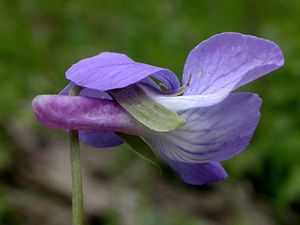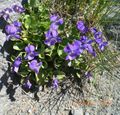Difference between revisions of "Viola adunca"
(Tag: VisualEditor) |
(→Description) (Tag: VisualEditor) |
||
| (8 intermediate revisions by the same user not shown) | |||
| Line 1: | Line 1: | ||
| − | * | + | *''Scientific Name: Viola adunca'' |
* Family: Violaceae | * Family: Violaceae | ||
| − | * early blue violet, blue violet, western dog violet | + | * Common Names: early blue violet, blue violet, western dog violet |
* Codon:VIOADU | * Codon:VIOADU | ||
| − | + | ---- | |
| − | ==Taxonomy== | + | [[File:VIOADU5.jpg|thumb|Photo by Ben Legler, also featured on Main Page]] |
| + | ===Taxonomy=== | ||
{{Taxobox | {{Taxobox | ||
| − | | name = | + | | name = |
| regnum = [[Plant]]ae | | regnum = [[Plant]]ae | ||
| − | | subregnum = | + | | subregnum = Viridiplantae |
| − | | phylum = | + | | phylum = Tracheophyta |
| − | | subphylum= | + | | subphylum= Spermatophytina |
| classis = Magnoliopsida | | classis = Magnoliopsida | ||
| subclassis = Rosanae | | subclassis = Rosanae | ||
| − | | ordo = | + | | ordo = Malpighiales |
| familia = Violaceae | | familia = Violaceae | ||
| − | | genus = | + | | genus = ''Viola'' L. |
| − | | species = '''''Viola adunca ''''' | + | | species = '''''Viola adunca ''''' Sm. |
| − | | binomial_authority = | + | | binomial_authority = |
}} | }} | ||
| + | <ref>Integrated Taxonomic Information System. Retrieved from https://www.itis.gov/servlet/SingleRpt/SingleRpt?search_topic=TSN&search_value=22032#null</ref> | ||
| − | ==Description== | + | ===Description=== |
| − | Perennial from | + | Perennial herb growing from slender rhizomes with purple flowers, stemless to 10 cm tall.<ref name=":0">MacKinnon, A., Pojar, Jim, & Alaback, Paul B. (2004). ''Plants of the Pacific Northwest coast : Washington, Oregon, British Columbia & Alaska'' (Rev. ed.). Vancouver: Lone Pine Pub.</ref> Leaves simple, entire to finely crenate,<ref name=":1">Jepson Herbarium Online Flora. Retrieved from https://ucjeps.berkeley.edu/eflora/eflora_display.php?tid=79074</ref> 1-3 cm long, cordate-ovate, petiolate.<ref name=":2" /> Flowers 5-merous, solitary, axillary, zygomorphic; sepals 5, lanceolate;<ref name=":1" /> petals 5, lowermost larger and spurred (spur 3-7 mm<ref name=":1" />), upper 4 in 2 pairs;<ref name=":3" /> lower 3 petals white proximally with dark violet veins, lateral 2 bearded;<ref name=":1" /> stamens 5, connivent around pistil;<ref name=":3" /> pistil 3-carpellate with 1 style, globose stigma<ref name=":3" /> and superior ovary with parietal placentation becoming a 3-valved capsule.<ref name=":2" /> |
| + | ===Bloom Period=== | ||
| + | April-August<ref name=":2">WTU Herbarium, Burke Museum, & University of Washington. Retrieved from https://biology.burke.washington.edu/herbarium/imagecollection/taxon.php?Taxon=Viola%20adunca</ref> | ||
| − | == | + | ===Distribution=== |
| − | + | Widespread, Alaska to California, both sides of Cascades, east to Atlantic.<ref name=":3">Hitchcock, C. L., Cronquist, A., Giblin, D., | |
| − | + | ||
| − | + | ||
| − | + | ||
& Legler, B. et al. (2018). ''Flora of the Pacific Northwest: an'' | & Legler, B. et al. (2018). ''Flora of the Pacific Northwest: an'' | ||
illustrated manual''. Seattle: University of Washington Press''</ref> | illustrated manual''. Seattle: University of Washington Press''</ref> | ||
| − | ==Habitat== | + | ===Habitat=== |
Dry to moist meadows, open woods, grasslands and open, disturbed ground from lowlands to near timberline<ref name=":0" /> | Dry to moist meadows, open woods, grasslands and open, disturbed ground from lowlands to near timberline<ref name=":0" /> | ||
| − | ==Uses== | + | ===Uses=== |
Ecological: Key food species for the larvae of the silverspot butterfly. | Ecological: Key food species for the larvae of the silverspot butterfly. | ||
Landscaping: Native violets "can produce the right substitute with a restrained beauty" to exotics such as pansies. "This is an easy, dependable and lovely plant for rather dry, open woods or lower reaches of the rockery in sun or partial shade." <ref>Kruckeberg, A. (1996). ''Gardening with native plants of the Pacific Northwest'' (2nd ed., rev. and enl. ed.). Seattle : Vancouver: University of Washington Press ; Greystone Books.</ref> | Landscaping: Native violets "can produce the right substitute with a restrained beauty" to exotics such as pansies. "This is an easy, dependable and lovely plant for rather dry, open woods or lower reaches of the rockery in sun or partial shade." <ref>Kruckeberg, A. (1996). ''Gardening with native plants of the Pacific Northwest'' (2nd ed., rev. and enl. ed.). Seattle : Vancouver: University of Washington Press ; Greystone Books.</ref> | ||
| − | |||
| − | |||
| − | ==Photo Gallery== | + | First Nations - Use by Blackfoot people as a dye. Use by several tribes as a treatment for external or stomach pain.<ref>Native |
| + | American Ethnobotany Database. Retrieved from http://naeb.brit.org/uses/search/?string=Viola+adunca</ref> | ||
| + | ===Propagation=== | ||
| + | Cold moist stratification improves germination. To stratify outdoors, sow in container from November through January, allow exposure to rain, do not protect from frost, until after germination. Best to sow several seeds into a single tray, pluck out and transplant individually in the spring. Emergence usually occurs once soil has warmed in April, sometimes May. Seed should be brown in color. Buff or pale colored seed indicates immature development.<ref>Cascadia Prairie Oak Partnership. Retrieved from https://www.cascadiaprairieoak.org/documents/PAD08PROFILESdblpages.pdf</ref> | ||
| + | |||
| + | ===Photo Gallery=== | ||
<gallery> | <gallery> | ||
File:VIOADU1.jpg | CNLM | File:VIOADU1.jpg | CNLM | ||
| Line 48: | Line 52: | ||
File:VIOADU3.png| Young leaf photo CNLM | File:VIOADU3.png| Young leaf photo CNLM | ||
File:VIOADU4.jpg| Seedling photo CNLM | File:VIOADU4.jpg| Seedling photo CNLM | ||
| − | File:VIOADU7.jpg|In fruit, photo by | + | File:VIOADU7.jpg|In fruit, photo by Roger T. George |
</gallery> | </gallery> | ||
| − | ==References== | + | ===References=== |
<references /> | <references /> | ||
Latest revision as of 15:20, 30 June 2021
- Scientific Name: Viola adunca
- Family: Violaceae
- Common Names: early blue violet, blue violet, western dog violet
- Codon:VIOADU
Contents
Taxonomy
| Scientific classification | |
|---|---|
| Kingdom: | Plantae |
| Subkingdom: | Viridiplantae |
| Phylum: | Tracheophyta |
| Subphylum: | Spermatophytina |
| Class: | Magnoliopsida |
| Subclass: | Rosanae |
| Order: | Malpighiales |
| Family: | Violaceae |
| Genus: | Viola L. |
| Species: | Viola adunca Sm. |
Description
Perennial herb growing from slender rhizomes with purple flowers, stemless to 10 cm tall.[2] Leaves simple, entire to finely crenate,[3] 1-3 cm long, cordate-ovate, petiolate.[4] Flowers 5-merous, solitary, axillary, zygomorphic; sepals 5, lanceolate;[3] petals 5, lowermost larger and spurred (spur 3-7 mm[3]), upper 4 in 2 pairs;[5] lower 3 petals white proximally with dark violet veins, lateral 2 bearded;[3] stamens 5, connivent around pistil;[5] pistil 3-carpellate with 1 style, globose stigma[5] and superior ovary with parietal placentation becoming a 3-valved capsule.[4]
Bloom Period
April-August[4]
Distribution
Widespread, Alaska to California, both sides of Cascades, east to Atlantic.[5]
Habitat
Dry to moist meadows, open woods, grasslands and open, disturbed ground from lowlands to near timberline[2]
Uses
Ecological: Key food species for the larvae of the silverspot butterfly.
Landscaping: Native violets "can produce the right substitute with a restrained beauty" to exotics such as pansies. "This is an easy, dependable and lovely plant for rather dry, open woods or lower reaches of the rockery in sun or partial shade." [6]
First Nations - Use by Blackfoot people as a dye. Use by several tribes as a treatment for external or stomach pain.[7]
Propagation
Cold moist stratification improves germination. To stratify outdoors, sow in container from November through January, allow exposure to rain, do not protect from frost, until after germination. Best to sow several seeds into a single tray, pluck out and transplant individually in the spring. Emergence usually occurs once soil has warmed in April, sometimes May. Seed should be brown in color. Buff or pale colored seed indicates immature development.[8]
Photo Gallery
References
- ↑ Integrated Taxonomic Information System. Retrieved from https://www.itis.gov/servlet/SingleRpt/SingleRpt?search_topic=TSN&search_value=22032#null
- ↑ 2.0 2.1 MacKinnon, A., Pojar, Jim, & Alaback, Paul B. (2004). Plants of the Pacific Northwest coast : Washington, Oregon, British Columbia & Alaska (Rev. ed.). Vancouver: Lone Pine Pub.
- ↑ 3.0 3.1 3.2 3.3 Jepson Herbarium Online Flora. Retrieved from https://ucjeps.berkeley.edu/eflora/eflora_display.php?tid=79074
- ↑ 4.0 4.1 4.2 WTU Herbarium, Burke Museum, & University of Washington. Retrieved from https://biology.burke.washington.edu/herbarium/imagecollection/taxon.php?Taxon=Viola%20adunca
- ↑ 5.0 5.1 5.2 5.3 Hitchcock, C. L., Cronquist, A., Giblin, D., & Legler, B. et al. (2018). Flora of the Pacific Northwest: an illustrated manual. Seattle: University of Washington Press
- ↑ Kruckeberg, A. (1996). Gardening with native plants of the Pacific Northwest (2nd ed., rev. and enl. ed.). Seattle : Vancouver: University of Washington Press ; Greystone Books.
- ↑ Native American Ethnobotany Database. Retrieved from http://naeb.brit.org/uses/search/?string=Viola+adunca
- ↑ Cascadia Prairie Oak Partnership. Retrieved from https://www.cascadiaprairieoak.org/documents/PAD08PROFILESdblpages.pdf






